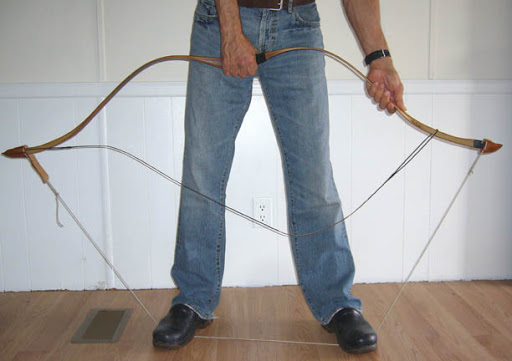How to String a Bow – Traditional to Compound
How to String a Bow – Horsebows to Recurves and Compounds
One of the most fundamental yet commonly overlooked aspects of being an archer is the stringing of the bow. This article shows you how to string a bow and also explores some historical stringing methods from archery’s past. There are many variations and methods that have developed for many different bows. This article will explain how to string a bow and explores some historical stringing methods.

How to String a Bow Using a Bow Stringer
This method is the safest and one of the easiest. Using this method will ensure minimal twisting of the bow limbs, which can cause damage to your bow. Minimal twisting occurs because the pressure is applied uniformly across the limbs while initially pulling the bow in place so the string may be placed in the nocks.
Stringing a bow using this method does require one piece of hardware: the bow stringer itself. There are several varieties of bow stringer available, but they are all constructed and operate in a similar way. One end of the bow stringer has either a saddle or pocket which fits over either the bow limb or the bow tip. The string is placed into the nock on one end and the pocket will be placed over the limb tip, holding the string in place. Standing on the bow stringer cord and pulling upwards bends the bow limbs into a position for the string to be applied.

How to String a Bow Using the Step-Through Method
This method of bowstringing is common for many types of archery and bows. Most traditional bows of the Eastern tradition are strung in a variation of the step-through method. Some variant of the step-through method, using the legs as a fulcrum to assist in bending the bow is depicted on ancient artifacts.
A Scythian burial in the Crimea discovered in 1830 and dating to the 4-5th century B.C. contains many items that give us a glimpse into the life of these ancient peoples. One artifact of particular interest is an electrum cup, which depicts moments in daily life, one of which is a warrior stringing his bow. He sits bracing one bow limb over one leg while pulling the other up under the back of his other leg.

The step-through method used most common today involves the archer standing. Placing a bow limb with one end of the string already nocked over one leg, the archer pulls the other limb forward, using the back of his other leg to brace the bow.
This method involves more strength and can cause twisting and damage to the bow. It is not recommended for heavier bows especially if they are horn bows as they are susceptible to damage by twisting of the limbs.
How to String a Bow Using the Push-Pull Method
This method involves resting one nocked end of the bow against the inside of your foot, then pulling the handle or center of the bow towards you, while pushing the other limb down and putting the string in place. Like the step-through method, this does take some practice and strength, depending on the draw weight of the bow being strung. This is a fairly common stringing method with longbows.
How to String a Bow – Seated Method
Several seated bowstringing methods exist. These methods can be used for heavier bows and for horn bows. Pulling back on the bow limbs while bracing the bow with the legs allows for even pressure to be applied to the bow limbs.
A variant of the seated method involves using a band or belt-like device that ties around the waist. This is known as a kemend in Turkish and was a method known to have been used in the Ottoman empire. Heavy war bows and bows for flight archery were strung using this method.
- Sit with the kemend looped around your waist once.
- Place the string onto the bow limbs and nock one end of the bowstring in place
- Attach each end of the kemend device to each bow limb
- Gently and smoothly press out your legs with feet braced against either side of the middle of the bow.
- When the bow is flexed enough, place the other end of the string into its respective nock.
- Release the pressure applied with the legs
Historical Bow Stringing Methods
As previously mentioned, a Scythian electrum cup discovered in Crimea clearly depicts an archer stringing a bow. Known as Kul-Oba, the archeological site contains a burial of a chieftain or high ranking Scythian nobleman, a woman, likely a wife, and a servant. This burial site or kurgan (discovered in 1830) was, in fact, the first ancient Scythian royal burian to be excavated in modern times.

The archer is basically using what I would call a kneeling step-through to string his bow. The relatively short length of the Scythian bow would make this a comfortable method to string a bow. The unique curvature of the Scythian bow also seems to lend itself to this stringing method very well.
Since the Scythians lived before and influenced so many bow-wielding steppe dwellers (Huns, Avars, Magyars, Mongols, Turks) it would be safe to say that some variation of step-through was used in ancient times.
Another method known to be used by Turkish archers involves a seated position and an apparatus known as a kemend. The kemend is a sash or belt looped around the waist of the archer. The ends of the device are placed around the limbs. The archer’s feet rest on either side of the bow handle. Pushing outwards with one’s legs, while simultaneously pulling one’s body backward bends the bow allowing it to be strung.

A traditional Japanese bow or Yumi typically gets strung with a variant of the push-pull method. While half kneeling, the bottom limb of the Yumi rests on the thigh. The top limb being already strung rests on the ground. Applying pressure to the handle bends the bow allowing for the lower limb to be strung.

How to String a Bow – Horsebow
If the bow is less than 60 pounds, the step-through method works well. If the bow composition contains horn, take care not to twist the limbs. A seated style or using a bow stringer would be preferred for heavier poundages or bows constructed with horn. Heavy hornbows can also be strung using a form. The bow curves around a premade form and is bound in shape so that the string may be applied.
How to String a Bow – Modern Recurve Bow
Modern recurves are very commonly strung with a bow stringer. This is a simple and effective way to avoid damaging the bow limbs and that is what we recommend for a modern recurve.
Stringing a Compound Bow
Stringing or restraining a modern compound bow complicates things a little bit more. After all, compound bows are no longer the simple, elegant devices that traditional bows are. A bow press and other specialized equipment may be required to properly string a compound. It is best left to the professionals likely to be found at your local hunting shop. Nevertheless, you can check out some of these videos of how the pros do it: